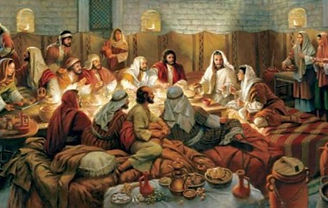Good Samaritan Church
Building the Beloved Community Since 1911
A New, Yet Anceint Way of Connecting with God
Why Do We Worship at Table?
Good Samaritan began experimenting with meal-based worship in 2016. The practice takes us back to the worship style of the first Jesus-following communities, but also connects us deeply with something for which we 21st century spiritual seekers hunger.





Ancient Roots
When Christ-followers first began to meet in the first century, they did so at lively dinner parties. Gathered around a meal, they shared stories, made meaning, prayed, sang together, and taught one another from the Torah (the Hebrew scriptures) as well as Jesus’ life and teachings. If the party was in a wealthy person’s home, they would provide the feast. If not, the group would meet in a rented “upper room” and share potluck style.
It was typical of dinner parties across the Roman Empire to break bread at the beginning of the meal, so it might be shared, and to enjoy wine at the end of the meal during symposium, a time of teaching and discussion. However, Christians began to infuse new meaning and symbolism into their meals together. They began to understand that at these meals, their hunger was fed, not just with bread, but the living bread of Jesus himself. Likewise, that their thirst was quenched, not just with wine, but with the new covenant of grace. They discovered that somehow through these meals they were knit into a beloved community of God’s people and became the body of Christ in their time and place.
They also began to depart from other Roman dinner parties in one important way: inclusivity. Where other dinner parties could be exclusive, welcoming only the wealthy or powerful elite, Christians began to welcome a much wider group of people, including slaves, servants, and foreigners. Where Roman parties would observe a strict hierarchy in their seating chart, giving positions of honor to the wealthiest and most powerful, Christians began to embrace a more open and egalitarian seating arrangement. They even invited women to stay and be part of the symposium time after dinner, where women were not traditionally welcome.
To say that Christians were perfectly inclusive and egalitarian would be an overstatement. They were a work in progress. The apostle Paul writes letters to several dinner churches, reminding them of their call in Christ to be different from the other Roman dinners: to share with each other — to save food for the working class, who would arrive to the feast after everyone else — to not be insular and feed only themselves, but to share their food with the wider community. Since the empire used dinner parties to reinforce the power structures and social strata, many saw the inclusivity of the early church as threatening to the empire, and that is part of what led to their persecution.
.jpg)
Re-Emergence Today
The tradition of worshiping around a meal, other than the symbolic meal of communion, eventually faded away until it was revived by the Moravians in Germany in 1727 where they shared a meal, prayed together, enjoyed spiritual conversation and the singing of hymns in what they called Agape Feasts.
Today many Christian communities are finding deep meaning in re-engaging in this style of worship. In fact, some new churches have formed that worship exclusively this way. Good Samaritan has been engaging in meal-based worship for 9 years and is currently working toward a vision of worshipping around a meal in a cafe space every week.
As Sister Margaret Basso, a spiritual retreat leader, once said, “When the bread is broken open for us, that is Eucharist. When we break ourselves open to each other, that is also Eucharist.” Something incredible can happen when we come together to share a meal. As we share food and conversation, our lives are opened up to each other. When we do this as an act of worship, it reminds us that God is deeply involved in all of our shared meals and every moment of community.
